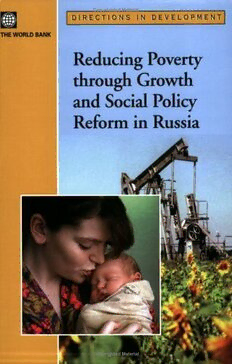
Reducing Poverty Through Growth And Social Policy Reform in Russia (Directions in Development) PDF
314 Pages·2006·1.948 MB·English
Most books are stored in the elastic cloud where traffic is expensive. For this reason, we have a limit on daily download.
Preview Reducing Poverty Through Growth And Social Policy Reform in Russia (Directions in Development)
Description:
Following the 1998 financial crisis, four out of every ten people slipped into poverty, not able to meet basic needs. Luckily, post-crisis economic rebound was impressive and broad-based - albeit uneven - across sectors and regions. This title explores the nature of poverty, both nationally and regionally, to identify the groups with a high poverty risk. It then examines growth-poverty linkages through the labor market, as well as the contribution of growth and inequality to the recent poverty reduction. It also considers the expected impact of WTO accession on overall growth and poverty. Finally, it focuses on the scope for improving social policy in ways that will have a direct impact on the poor. Following the 1998 financial crisis, a steep drop in consumption occurred across all income groups, but especially hurting the poor. Four out of every ten people slipped into poverty, not able to meet basic needs. Luckily, post-crisis economic rebound was impressive and broad-based -- albeit uneven -- across sectors and regions. The report analyzes the main facets and dynamics of poverty in Russia from 1997 to 2003. The analysis was conducted by Russian and international experts as part of a collaborative project by the World Bank, the United Kingdom Department for International Development, and the Russian government team comprising the Ministry of Labor and Social Development, the Goskomstat, the Ministry of Economic Development and Trade, and the Ministry of Finance. For the first time, this report has been able to utilize the vast micro data of the Household Budget Survey, a Goskomstat survey of 49,000 Russian households, conducted regularly since 1952. In addition, it presents practically the first poverty-related analysis of the data collected under the NOBUS - the Goskomstat survey of householdsA? access to social services, carried out in 2003. The report explores the nature of poverty, both nationally and regionally, to identify the groups with a high poverty risk. Next, the report examines growth-poverty linkages through the labor market, as well as the contribution of growth and inequality to the recent poverty reduction. It also considers the expected impact of WTO accession on overall growth and poverty. Finally, the report focuses on the scope for improving social policy in ways that will have a direct impact on the poor. The last chapter of the report provides recommendations for improved monitoring of poverty outcomes on the basis of the Household Budget Survey.
See more
The list of books you might like
Most books are stored in the elastic cloud where traffic is expensive. For this reason, we have a limit on daily download.
